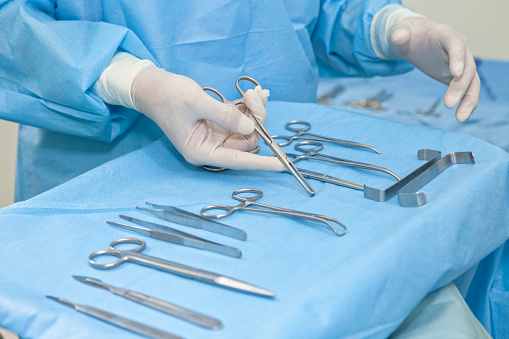When is Surgical Instrument Discoloration a Cause for Concern?

By Hassan Bilal, CRCST, CST | February 23, 2017
It can be an alarming sight: brown discoloration of stainless steel instruments that have already been cleaned and sterilized for use in the operating room. It turns out that this is a common problem and that instrument staining occurs daily in hospitals all across the country and in recent years, The Joint Commission has increased its efforts to promote how important the role of Central Sterile is in preventing Health Care-Acquired Infections (HAIs).¹ Hospitals are under the microscope from the U.S. Department of Health & Human Services to even Consumer Reports’ compiling its own list of hospital rankings by tracking hospital infection records as HAIs are now the nation’s eighth leading cause of death, just behind diabetes.²
There is even more scrutiny to make sure every aspect within the hospital is performing at its best. The Central Sterile and Operating Room personnel may have anywhere from a basic knowledge to a very detailed knowledge of the workings and Instructions For Use (IFU) of their equipment.
So what to do next? Here are some things to keep in mind:
Rust vs. Staining
In many sterile processing departments, employees will discover the brown spots and first assume it is rust. As we know, rust is a big issue and can cause infection. So the sterile processing team needs to take additional measures to test for rust. One easy way to do this is to use an instrument care wipe to see if the brown coloring on the instrument can be removed. If the discoloration cannot be removed, then it could potentially be rust and you should reach out to your instrument provider to determine next quality assurance steps to take. Most commonly, that discoloration comes right off and that means it is merely staining. This is good news because, despite the initial appearance, staining does not impact the sterility of the instrument or put the patient at greater risk.
The Source of Staining
Staining can be a result of a number of different variables. In most instances, staining is a byproduct of poor steam quality and the unwanted addition of magnesium and calcium accumulating during the sterilization process. Another possibility is the buildup of detergent build up from instrument cleaning and inadequate removal of soap residues. Either way, a thorough wash and some scrubbing general brings the instruments right back to their desired state.
Bad Steam?
You can tell if your steam has a problem by looking at the hospital’s sterilizer. If there is lime buildup, this is a clear sign that the system needs to be treated by reverse osmosis or deionized water. In my travels, I find that facilities that take steps to ensure steam quality will eliminate their staining issues immediately.
Where to Start?
In general, if you’re facing any similar issues with you instruments or central sterile products and would like some input on corrective actions – reach out to Medline. Our consultants are trained to evaluate common facility issues for effective corrective actions. In this instance, while Medline doesn’t offer water treatment, our team has decades of central sterile consulting experience and can help point you in the right direction to get to the root of any department problems – just like staining.
What issues is your sterile processing department dealing with?
Sources:
1. 2017 National Patient Safety Goals Presentation. https://www.jointcommission.org/npsg_presentation/. The Joint Commission, November 22, 2016.
2. Zero Tolerance for Deadly Hospital-Acquired Infections. http://www.consumerreports.org/hospital-safety/hospital-acquired-infections-zero-tolerance/. Consumer Reports, Nov. 21, 2016.
Hassan Bilal, CRCST, CST
Operating Room Educational Consultant
Hassan Bilal supports and advises a sales force of over 1,000 Medline sales representatives on central sterile products, standards and technology which cover the United States and Canada. He is a voting member on the ST79 Sterilization Standards Committee for the Association for the Advancement of Medical Instrumentation (AAMI). He has instructed classes for Certified Surgical Technologist. He has also taught certification classes for students of the Central Sterile Association of Canada throughout Ontario. He speaks nationally at local, regional and state IAHCSMM chapters. He has also spoken at numerous Central Sterile departments, AHRMM conferences and AORN chapters.

